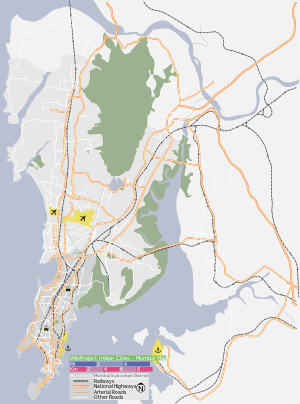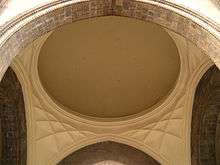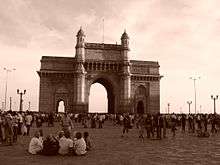Gateway of India
| Gateway of India | |
|---|---|
|
View of Gateway of India at night | |
 Location within Mumbai | |
| General information | |
| Architectural style | Indo-Saracenic |
| Location | Mumbai, Maharashtra |
| Coordinates | 18°55′19″N 72°50′05″E / 18.9219°N 72.8346°E |
| Elevation | 10 m (33 ft) |
| Construction started | 31 March 1913 |
| Completed | 1924 |
| Inaugurated | 4 December 1924 |
| Cost | ₹ 2.1 million (1913) |
| Owner | Archaeological Survey of India |
| Height | 26 m (85 ft) |
| Dimensions | |
| Diameter | 15 metres (49 feet) |
| Design and construction | |
| Architect | George Wittet |
| Architecture firm | Gammon India[1] |
| Renovating team | |
| Architect | George Wittet |
The Gateway of India is a monument built during the 20th century in Mumbai City of Maharashtra state in Western India.[2] It is located on the waterfront in the Apollo Bunder area in South Mumbai and overlooks the Arabian Sea.[3][4] The structure is a basalt arch, 26 metres (85 feet) high. It lies at the end of Chhatrapati Shivaji Marg at the water's edge in Mumbai Harbour.[5] It was a crude jetty used by the fishing community which was later renovated and used as a landing place for British governors and other prominent people. In earlier times, it would have been the first structure that visitors arriving by boat in Mumbai would have seen.[6][7] The Gateway has also been referred to as the Taj Mahal of Mumbai,[8] and is the city's top tourist attraction.[9] The structure was erected to commemorate the landing of King George V and Queen Mary at Apollo Bunder, when they visited India in 1911. Built in Indo-Saracenic style, the foundation stone for the Gateway of India was laid on 31 March 1911. The final design of George Wittet was sanctioned in 1914 and the construction of the monument was completed in 1924. The Gateway was later the ceremonial entrance to India for Viceroys and the new Governors of Bombay.[10] It served to allow entry and access to India.[11]
The monument has witnessed three terror attacks since the beginning of the 21st century; twice in 2003 and it was also the disembarkation point in 2008 when four gunmen attacked the Taj Mahal Palace & Tower.
History
The Gateway of India was built to commemorate the visit of King George V and Queen Mary to Mumbai, prior to the Delhi Durbar, in December 1911. However, they only got to see a cardboard model of the structure since the construction did not begin till 1915.[12] The foundation stone was laid on March 31, 1911, by the governor of Bombay Sir George Sydenham Clarke, with the final design of George Wittet sanctioned on March 31, 1914. The gateway was built from yellow basalt and concrete.[13] Between 1915 and 1919, work proceeded at Apollo Bundar (Port) to reclaim the land on which the gateway and the new sea wall would be built. The foundations were completed in 1920, and construction was finished in 1924.[14] The gateway was opened on December 4, 1924, by the Viceroy, the Earl of Reading.[6]
The last British troops to leave India following the country's independence, the First Battalion of the Somerset Light Infantry, passed through the Gateway on their way out in a ceremony on February 28, 1948, signalling the end of British rule.[6][15]
Design and structure

The Scottish architect George Wittet combined the elements of the Roman triumphal arch and the 16th-century architecture of Gujarat.[16] Its design is a combination of Hindu and Muslim architectural styles; the arch is of Muslim style while the decorations are of Hindu style.[17] The gateway is built from yellow basalt and reinforced concrete.[12] The stone was locally obtained, and the perforated screens were brought from Gwalior.[18] The gateway faces out to Mumbai Harbour from the tip of Apollo Bunder.[19]
The central dome is 48 feet (15 metres) in diameter and 83 feet (25 metres) above the ground at its highest point.[20] The whole harbour front was realigned in order to come in line with a planned esplanade which would sweep down to the centre of the town. On each side of the arch, there are large halls that can hold 600 people.[12] The cost of the construction was ₹2 million (US$30,000), borne mainly by the Imperial Government of India. Due to a paucity of funds, the approach road was never built, and so the gateway stands at an angle to the road leading up to it.[6][20]
Significance
It is the place where the viceroys and governors used to land upon their arrival in India. Though built as a welcome to King George V for his visit of 1911, then an event of grand significance for British India and the British empire, today serves as a "monumental memento" of British colonial rule over India.[11] Built right next to the Taj Mahal Palace & Tower hotel,[21] for British arriving for the first time to India, the gateway was a symbol of the "power and majesty" of the British empire.[3]
Opposite the gateway stands the statue of Shivaji, the king who used guerilla warfare to establish the Maratha empire in the Sahyadri mountain range in the 17th century,[22] as a symbol of Maratha "pride and courage".[23] The statue was unveiled on 26 January 1961 on the occasion of India's Republic Day.[24][25] The other statue in the area is that of Swami Vivekananda, by renowned sculptor Sitaram S. Arte.[26]
There are five jetties at the gateway.[27] The first jetty is exclusive to the Atomic Research Centre, the second and third are used for commercial ferry operations, the fourth is closed and the fifth is exclusive to the Royal Bombay Yacht Club.

After the 2008 Mumbai attacks, there has been a proposal to close all these jetties and replace them with two newer ones to be built near the Bombay Presidency Radio Club nearby.[28] The second and third jetties are the starting point for tours of Elephanta Caves, which is a 50-minute boat ride away by ferry.[21][29] Other routes from the Gateway include ferry rides to Alibaug and Mandwa; these ferries are said to carry passengers above their certified capacity due to their popularity.[30]
The Gateway of India is a major tourist destination and a popular gathering spot for locals, street vendors and photographers.[19] In 2012, Maharashtra Tourism Development Corporation moved the "Elephanta Festival of music and dance" from its original location at Elephanta Caves (where it had been celebrated for 23 years) to the Gateway due to the increased capacity offered by the venue. The Gateway can host 2,000 to 2,500 people, whereas Elephanta Caves could host only 700 to 800 people.[31][32]
A bomb planted in a taxi exploded near the gateway in the 2003.[9] The gateway was also the site of a major bomb-blast in August 2003 and was the disembarkation point of the terrorists participating in the November 2008 terror attacks when four gunmen attacked the Taj Mahal Palace & Tower.[33] Public movement in certain areas was restricted after the 2008 attacks.[34]
See also
- List of tourist attractions in Mumbai
- India Gate
- Tourist attractions in Aurangabad, Maharashtra
- Make In Maharashtra
- Royal Bombay Yacht Club – the building directly opposite the Gateway to India
References
- ↑ "Which company built the Gateway of India?". Rediff.com. 4 May 2007. Retrieved 30 April 2012.
- ↑ National Portal Content Management Team. "National Portal of India, Monuments". National Informatics Centre (NIC). Retrieved 23 April 2012.
- 1 2 William J. Duiker; Jackson J. Spielvogel (3 January 2006). World History: From 1500. Cengage Learning. p. 582. ISBN 978-0-495-05054-4. Retrieved 3 April 2012.
- ↑ DNA (24 April 2012). "Walk amid a wealth of heritage in Mumbai". DNA India. Mumbai. Retrieved 24 April 2012.
- ↑ Holloway, James (29 November 1964). "Gateway of India; Colorful, Crowded Bombay Provides An Introduction to Subcontinent". The New York Times. Retrieved 26 November 2012.(subscription required)
- 1 2 3 4 Dwivedi, Sharada; Rahul Mehotra (1995). Bombay – The Cities Within. Mumbai: India Book House. ISBN 81-85028-80-X.
- ↑ Arnett, Robert (15 July 2006). India Unveiled. Atman Press. p. 166. ISBN 978-0-9652900-4-3. Retrieved 22 April 2012.
- ↑ Duncan Forbes (1968). The heart of India. Hale. p. 76. Retrieved 3 April 2012.
- 1 2 "2003: Bombay rocked by twin car bombs". BBC. 25 August 2003. Retrieved 16 April 2012.
- ↑ Chapman, Kenneth. Peace, War and Friendships. Roxana Chapman. p. 151. ISBN 978-0-9551881-0-7. Retrieved 16 April 2012.
- 1 2 Simon, Sherry; St-Pierre, Paul (27 November 2000). Changing the Terms: Translating in the Postcolonial Era. University of Ottawa Press. p. 245. ISBN 978-0-7766-0524-1. Retrieved 22 April 2012.
- 1 2 3 Mis, Melody S. (1 August 2005). How to Draw India's Sights and Symbols. Rosen Publishing. p. 42. ISBN 978-1-4042-2732-3. Retrieved 16 April 2012.
- ↑ "Gateway of India".
- ↑ Dwivedi, Sharada; Mehrotra, Rahul (1995). Bombay: the cities within. India Book House. ISBN 978-81-85028-80-4. Retrieved 16 April 2012.
- ↑ Bradnock, Robert; Bradnock, Roma; Ballard, Sebastian (1993). South Asian handbook. Trade & Travel. ISBN 978-0-8442-9980-8. Retrieved 30 April 2012.
- ↑ Shobhna Gupta (2003). Monuments of India. Har-Anand Publications. p. 111. ISBN 978-81-241-0926-7. Retrieved 3 April 2012.
- ↑ Sigh, Kirpal; Mathew, Annie. Middle School Social Sciences. Frank Brothers. p. 8. ISBN 978-81-8409-103-8. Retrieved 16 April 2012.
- ↑ Bajwa, Jagir Singh; Kaur, Ravinder (1 January 2007). Tourism Management. APH Publishing. p. 240. ISBN 978-81-313-0047-3. Retrieved 16 April 2012.
- 1 2 Singh, Sarina (1 September 2009). Lonely Planet India. Lonely Planet. pp. 783–784. ISBN 978-1-74179-151-8. Retrieved 18 April 2012.
- 1 2 Kapoor, Subodh (1 July 2002). The Indian Encyclopaedia. Cosmo Publications. p. 2554. ISBN 978-81-7755-257-7. Retrieved 22 April 2012.
- 1 2 Pippa De Bruyn; Keith Bain; David Allardice; Shonar Joshi (12 February 2010). Frommer's India. John Wiley & Sons. p. 125. ISBN 978-0-470-60264-5. Retrieved 3 April 2012.
- ↑ "300-feet Shivaji statue in Mumbai's Arabian Sea!". 3 June 2008. Rediff.com. Retrieved 16 April 2012.
- ↑ B.K. Chaturvedi. Tourist Centers of India. Diamond Pocket Books (P) Ltd. p. 146. ISBN 978-81-7182-137-2. Retrieved 3 April 2012.
- ↑ Prasad, Rajendra (1984). Dr. Rajendra Prasad, Correspondence and Select Documents. Allied Publishers. p. 205. ISBN 978-81-7023-002-1. Retrieved 16 April 2012.
- ↑ University of Michigan (1965). The Illustrated weekly of India. Bennett, Coleman & Co., Ltd. p. 152. Retrieved 16 April 2012.
- ↑ Kottis, George C. (30 October 2006). Follow the Wind of Your Soul. AuthorHouse. p. 101. ISBN 978-1-4259-5505-2. Retrieved 19 May 2012.
- ↑ Thakkar, Dharmesh (27 January 2009). "Gateway of India jetties to move location". NDTV. Retrieved 30 April 2012.
- ↑ "5 jetties may be shut". Daily News and Analysis. 29 January 2009. Retrieved 30 April 2012.
- ↑ DNA (18 April 2012). "Mumbai heritage week: Revisiting a lost culture in the city of caves". DNA India. Retrieved 18 April 2012.
- ↑ "Disaster floats at gateway". Mid Day. 2 October 2011. Retrieved 30 April 2012.
- ↑ Tembhekar, Chittaranjan; Jaisinghani, Bella (5 March 2012). "Elephanta festival 'moves' to Gateway of India". The Times of India. Retrieved 30 April 2012.
- ↑ "Festival weaves magic". The Indian Express. Mumbai. Express news service. 27 March 2012. Retrieved 30 November 2012.
- ↑ Outlook Publishing (8 December 2008). Outlook. Outlook Publishing. p. 35. Retrieved 3 April 2012.
- ↑ Clara Lewis, Times News Network (18 March 2012). "Gateway not quite a getaway". The Times of India. Retrieved 4 April 2012.
External links
| Wikimedia Commons has media related to Gateway of India. |
Coordinates: 18°55′19″N 72°50′05″E / 18.9219°N 72.8346°E
